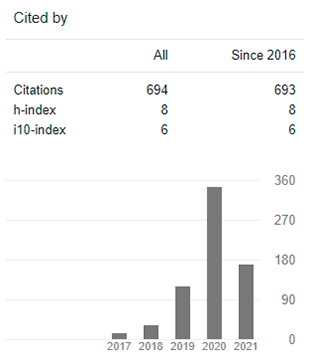Technologies in the organization of an inclusive classroom for children with special abilities
DOI:
https://doi.org/10.29394/Scientific.issn.2542-2987.2020.5.16.18.334-351Keywords:
educational management, teacher role, educational needsAbstract
This essay addresses how attention to diversity within an inclusive classroom can generate significant learning, using ICT, with inclusion being a basic commitment in the construction of quality education, as Parrilla (2004), points out, highlighting that the Learning is a right and a possibility of participation in the learning process. This approach aims to carry out a true integration of all students attending to diversity as proposed by Fernández and Bermejo (2012), through positive attitudes of teachers and an adequate use of ICT, which provide better care for children with Educational Needs Special associated or not with disability. The use of ICT generates many advantages in the educational field, but also, some barriers or obstacles that hinder or impede equal opportunities, as highlighted by Corrales, Soto and Villafañe (2016). These barriers will be overcome with an educational management that merges all educational actors, where the role of the teacher is innovative using all the tools available to them, including technological ones, so that students develop their abilities and skills from their particularities and so that they contribute even more to the whole of society.
Downloads
References
Araque, N., & Barrio, J. (2010). Atención a la diversidad y desarrollo de procesos educativos inclusivos. Prisma Social, (4),1-37, e-ISSN: 1989-3469. Recuperado de: https://dialnet.unirioja.es/servlet/articulo?codigo=3632700
Corrales, A., Soto, V., & Villafañe, G. (2016a,b). Barreras de aprendizaje para estudiantes con discapacidad en una universidad chilena. Demandas estudiantiles y desafíos institucionales. Actualidades Investigativas en Educación, 16(3), 1-29, e-ISSN: 1409-4703. Recuperado de: https://doi.org/10.15517/aie.v16i3.25957
CONADIS (2020). Estadísticas de Discapacidad. Quito, Ecuador: Consejo Nacional para la Igualdad de Discapacidades. Recuperado de: https://www.consejodiscapacidades.gob.ec/estadisticas-de-discapacidad/
Domínguez, J., Guarda, T., Torres, W., Bustos, S., Villao, F., Sánchez, J., ... Ponce, V. (2019). Herramientas Tecnológicas Contribuyendo a la Inclusión de Personas con Necesidades Especiales. risti: Revista Ibérica de Sistemas e Tecnologias de Informação, (E18), 302-309, e-ISSN: 1646-9895. Recuperado de: http://www.risti.xyz/issues/ristie18.pdf
Echeita, G. (2013). Inclusión y exclusión educativa. De nuevo “Voz y Quebranto”. REICE. Revista Iberoamericana sobre Calidad, Eficacia y Cambio en Educación, 11(2), 99-118, e-ISSN: 1696-4713. Recuperado de: https://www.redalyc.org/pdf/551/55127024005.pdf
Fernández, J., & Bermejo, B. (2012). Actitudes docentes hacia las TIC en centros de buenas prácticas educativas con orientación inclusiva. Enseñanza & Teaching, 30(1), 45-61, e-ISSN: 0212-5374. Recuperado de: https://revistas.usal.es/index.php/0212-5374/article/view/9296
Holzschuher, C. (2012). Cómo organizar aulas inclusivas: Propuestas y estrategias para acoger las diferencias. Madrid, España: Narcea Ediciones.
Parrilla, M. (2004). La construcción del aula como comunidad de todos. Organización y gestión educativa, 12(2), 19-29, ISSN: 1134-0312. España: Fórum Europeo de Administradores de la Educación.
Rodríguez, M., & Arroyo, M. (2014). Las TIC al servicio de la inclusión educativa. Digital Education Review, (25), 108-126, e-ISSN: 2013-9144. Recuperado de: https://dialnet.unirioja.es/servlet/articulo?codigo=4778259
Downloads
Published
How to Cite
Issue
Section
License
The content of the journals of this site, are under a Creative Commons Attribution-Noncommercial-Share Alike 4.0 International License.













